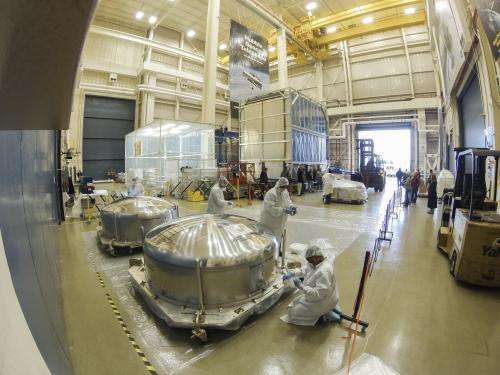Final James Webb Space Telescope mirrors arrive at NASA

The final three of 18 primary mirrors for NASA's James Webb Space Telescope arrived at NASA's Goddard Space Flight Center in Greenbelt, Md., for integration prior to a scheduled launch in 2018.
Once on orbit, the 18 hexagonal mirror segments will work together as one 21.3-foot (6.5-meter) primary mirror, the largest mirror ever flown in space and the first to deploy in space.
"Having the final mirror segments at Goddard is an exciting program milestone. It's the culmination of more than a decade of advanced optics manufacturing and testing work by teams of extremely dedicated engineers, technicians and scientists," said Eric Smith, NASA's acting Webb telescope director in Washington. "These mirrors are ready to meet up with the structure that will hold them incredibly stable, forming Webb's 6.5-meter-diameter primary mirror—the largest space telescope ever built."
The mirrors were built by Ball Aerospace and Technologies Corporation, Boulder, Colo. Ball is the principal subcontractor to Northrop Grumman for the optical technology and lightweight mirror system. Ball Aerospace also developed the secondary mirror, tertiary mirror and fine-steering mirror.
"Ball's sophisticated mirror architecture will provide James Webb with the most advanced infrared vision of any space observatory ever launched by NASA," said Robert Strain, Ball Aerospace president. "A huge amount of teamwork was needed to meet the exacting requirements for the telescope's optical design and we're eager to see the results."
Ball began an incremental process of shipping the finished mirrors to Goddard in September 2012. The mirrors are housed in custom shipping containers designed specifically for the multiple cross-country trips the mirrors made through eight U.S. states during manufacturing. Each container is hermetically sealed to handle atmospheric pressure changes caused by shipping from high elevations such as Boulder to locations at or near sea level such as Greenbelt.
The premier observatory for the next decade, the Webb telescope will be stationed 1 million miles (1.5 million km) from Earth – some four times farther away from us than the moon. Webb will be the most powerful space telescope ever built, able to detect the light from the first galaxies ever formed and explore planets around distant stars. It will study every phase of our universe's history, ranging from the first luminous glows after the Big Bang, to the formation of stellar systems capable of supporting life on planets like Earth, to the evolution of our own solar system.
Provided by NASA's Goddard Space Flight Center


















